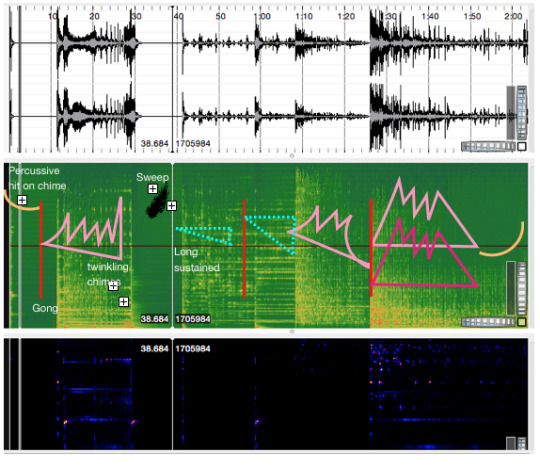My name is Kaylyn. I explore with modular synth, make noise shared system, arduino board, and at times playing classical songs on my piano or engage in collaborative projects. Currently an undergraduate from Lasalle College of the Arts, studying Ba(Hons) in Electronic Music.
Don't wanna be here? Send us removal request.
Text
6(b) Summary of Denis Smalley’s Wind Chimes Analysis

Figure 2: Screenshot of Section1 “Wind Chimes” on Sonic Visualiser.
In section one of Wind Chimes, we can observe from the spectrogram that at the start of the piece there was a single sound event played by a percussive strike onto the chimes.
Afterward, the immediate loud strong attack of the gong disrupt the short silence from the percussive strike of the chimes, in which it leads to continuous resonances of the twinkling chimes.
A short four-second silence was then interrupted by a fast high-frequency sweep, probably a fast scraped sound source. Followed by the layering of sustained sounds, in return make the entire piece more spacious and atmospheric.
The gong sound re-appeared again with the twinkling chimes but with a wider dynamic range and larger pitch frequency range. The section ended off with the percussive hit on the chime sound.
All sounds found in section one were untreated and purely acoustic.
The highlight of section one was the continuous attack of sounds in section one proves that it creates tension and dynamic range and texture in a piece itself.
In addition, the layering of high pitch chime sounds with the contrast of low-end percussive sounds, shows that the re-use of sound source materials is special technique used by Denis Smalley that stood out in this piece.
0 notes
Text
6(a) Summary of Denis Smalley’s Wind Chimes Analysis


Figure 1: Screenshot of “Wind Chimes” on Sonic Visualiser.
Song: Wind Chimes
Composed by: Denis Smalley
Year released: 1995. T
Album: No.5 on Archives GRM, [Disc 3] : Le Son En Nombres
Sound sources: ceramic chimes(striking, scraping and knocking the pipes), bass drum, metallic wind chimes, resonant metal bars, piano sounds and digital synthesis.
Structure/Texture:
Section1 (start-2min) of the piece featured sounds that are mainly has strong attack with high frequency pitches as shown in pitch frequency spectrogram. Sounds were mainly untreated and purely acoustic.
Section 2 (2-6min) of the piece is dived into three main parts. Firstly, it started out with strong continuous sharp attack, long decays and high pitch frequency sounds. Next, it moved on to a more rhythmically patterned piece which consists of large usage of sound processing and filtering manipulation. The section ended of with loud and intense drum rhythm patterns.
Section 3 (6min-end) shows grainy sustained sounds being played sounded melodic as shown in spectrogram.
0 notes
Text
5
Was task to read up about Fluxus experimental music.
Summary:
Fluxus was an avant-garde art movement that emerged in the late 1950s.
They were most heavily influenced by the ideas of John Cage, who believed that one should embark on a piece without having a conception of the eventual end.
It was the process of creating that was important, not the finished product (eg. Cage’s 4′33).
Also, everyday objects aare the element of chance in arts (eg.Water Music).
0 notes
Text
4

Notes: Analysis of piece “Orient-Occident” by Iannis Xenakis
0 notes
Audio
The sample used was from one of my compositions.
Manipulated the EA Music Primer application using Pierre’s PlayHouse project.
Enjoy! :)
0 notes
Text
3

Explored Electro-Acousmatic Music Primer Application.
The application teaches some basic audio principles and common synthesis techniques.
Decided to try out Pierre’s Playhouse project patch.
Used one of my composition as a sample.
Manipulated with the midi keyboard by changing the pitch EG.
Changed the variable speed slider by selecting different direction control.
Loop the songs at various point to create different sound textures and dynamic range, which is also manipulated by the LFO amplitude.
To listen to the new recorded audio:
https://soundcloud.com/wavwav/ea-musicprimer-breathe-edited
0 notes
Text
2
Electro-Acousmatic Music

Notes:
Musique Concrete (by Pierre Schaeffer; French Composer)
Classical Music is a form of surrealism.
Comparison of composing techniques (Concrete VS Abstract)
Frequency Modulation (FM) - creates vibrato
Amplitude Modulation (AM) - creates tremolo
Process of Electro-Sound composition:
record sound source > manipulate/process the sound > by filtering, using loops, stretching it, using echo-chamber etc. > composed on tape machines > composer’s idea > scoring > conductors > interpretation > performers > create sound by playing it > listener listens (one way approach system)
Some characteristics to describe sounds:
organic, synthetic, timber, pitch, rhythm, gesture, texture, evolution of pitch time and duration, density, dynamic space, transition (eg. cut, fades, masking, interruption), frequency(high, mid, low), foreground/middleground/background etc.
Song References:
ESPECES and ARTICULATION by Ligeti (Germany, synthetic sounds)
0 notes
Text
1
MicroMontage (Sound collage)

Montage ( literally means “putting together)” is a technique where newly branded sound objects or compositions are created from collage.
Micromontage is the use of montage on the time scale of micro sounds.
Eg. Composer Haracio Vaggione in works such as Octuor (1992) and Schall (1995).
Technique:
extraction and arrangement of sound particles from a sample.
exact placement of each particle to create complex sound patterns.
able to splice each piano note into smaller samples
pitch shifting involved
Granular synthesis incorporates many of the techniques of micro-montage.
Eg. Max for live: the mono lake granulator (youtube)
Watched a documentary in class called “Sound Breaking / Going Electric”
0 notes